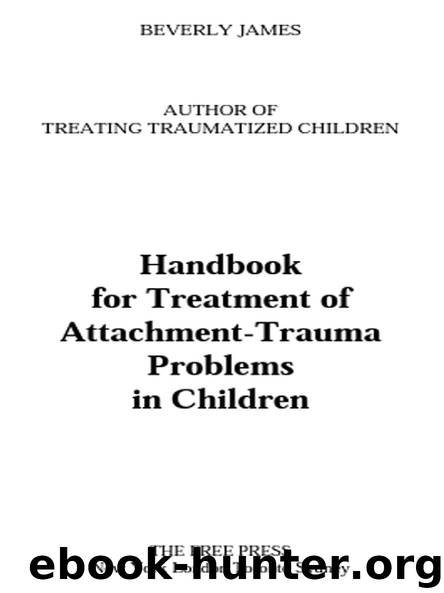Handbook for Treatment of Attachment-Trauma Problems in Children by Beverly James

Author:Beverly James
Language: eng
Format: epub
Publisher: POCKET BOOKS
Published: 2003-07-15T00:00:00+00:00
Working through Loss in Dramatic Play
Niki was a then four-year-old girl who lived in foster care due to a history of severe deprivation and neglect. Her mother, twenty-year-old Tamara, was also severely neglected as a child and spent little time feeding, holding, nurturing, or caring for her child. This lack of nutritional and physical nurturing caused the baby to develop nonorganic “failure to thrive.” When Tamara took the child at age three to a physician because the baby was not toilet-trained, the child was immediately hospitalized. Niki was suffering from severe malnutrition and showed signs of minimal care: She had impetigo on her face and hands, a massive rash on her vaginal area, and lice in her hair. She was developmentally delayed in her language and expressive abilities. She could not walk, both from weakness and because her muscles were constricted from her having been mostly confined to her crib. She had never been immunized and had signs of untreated ear infections and tonsillitis. Tamara was charged with criminal neglect, and parental rights were terminated six months after Niki’s hospitalization. When she was released from the hospital, Niki was referred both to a fost-adopt placement and for psychotherapeutic treatment.
The foster mother reported that Niki was lethargic and passive. She did not cry, even when soiled or hungry. She preferred to stay in one spot, apparently uncomfortable with being out of her crib. She didn’t seem interested in toys and usually clutched her blanket in her hands. Niki flinched when the foster mother came into the room in the morning.
Niki was unresponsive in therapy as well. She did not play spontaneously and required stimulation to become interested in toys. I did parallel play with her to awaken her interest in various activities. Sitting next to her, I would make sure she watched as I rolled a ball, cut cardboard into shapes, played with water, built blocks, and did a variety of other things. She usually sat staring, with fingers of both hands in her mouth. She did not speak, and a special tutor was helping her develop linguistic skills.
The youngster remained unattached and reticent during the first four months of therapy, although she did become accustomed to the small playroom and my constancy. I would often introduce different toys to gauge her interest. She definitely liked playing with the sand in the sandtray, pouring sand from one cup into another and pouring water on the sand, watching it absorb and dry. She eventually focused on a mother pig with seven piglets and brought them into the sandtray. From this time forward her play took on different characteristics, becoming repetitive and exact. At every session for about three months, she buried the mother pig in the left-hand corner of the sandtray. The piglets were placed in the opposite corner, and they took turns trying to find the mother pig. The child said nothing during this play, yet appeared to be absorbed in what she was doing, frequently showing a low-range affective variance.
Download
This site does not store any files on its server. We only index and link to content provided by other sites. Please contact the content providers to delete copyright contents if any and email us, we'll remove relevant links or contents immediately.
Periodization Training for Sports by Tudor Bompa(8168)
Why We Sleep: Unlocking the Power of Sleep and Dreams by Matthew Walker(6618)
Paper Towns by Green John(5086)
The Immortal Life of Henrietta Lacks by Rebecca Skloot(4523)
The Sports Rules Book by Human Kinetics(4288)
Dynamic Alignment Through Imagery by Eric Franklin(4115)
ACSM's Complete Guide to Fitness & Health by ACSM(3987)
Kaplan MCAT Organic Chemistry Review: Created for MCAT 2015 (Kaplan Test Prep) by Kaplan(3938)
Introduction to Kinesiology by Shirl J. Hoffman(3720)
Livewired by David Eagleman(3682)
The Death of the Heart by Elizabeth Bowen(3550)
The River of Consciousness by Oliver Sacks(3534)
Alchemy and Alchemists by C. J. S. Thompson(3447)
Bad Pharma by Ben Goldacre(3352)
Descartes' Error by Antonio Damasio(3229)
The Emperor of All Maladies: A Biography of Cancer by Siddhartha Mukherjee(3061)
The Gene: An Intimate History by Siddhartha Mukherjee(3046)
The Fate of Rome: Climate, Disease, and the End of an Empire (The Princeton History of the Ancient World) by Kyle Harper(3003)
Kaplan MCAT Behavioral Sciences Review: Created for MCAT 2015 (Kaplan Test Prep) by Kaplan(2935)
